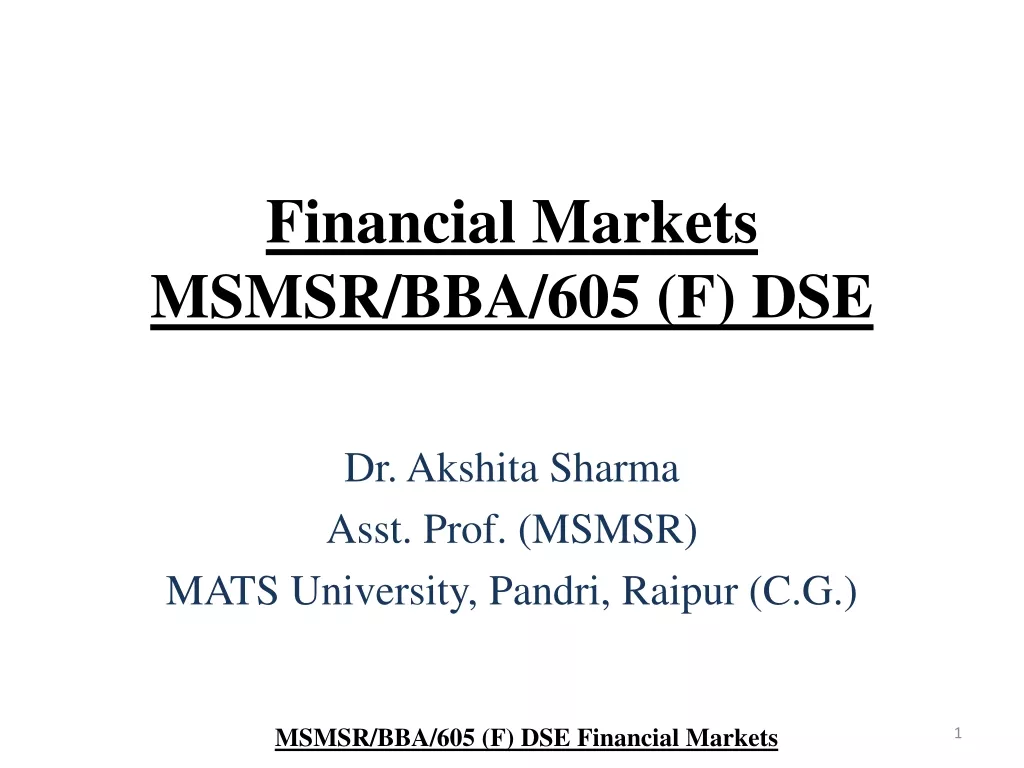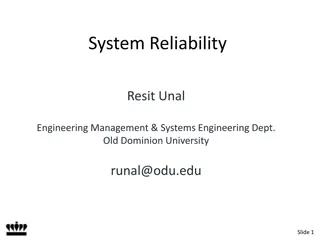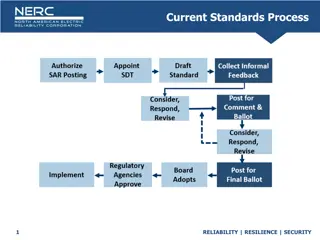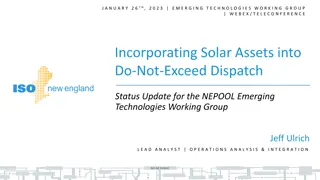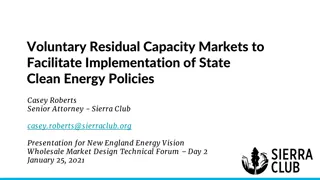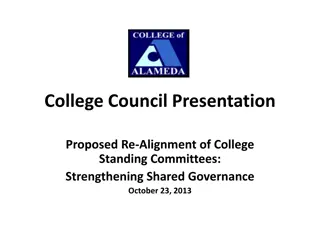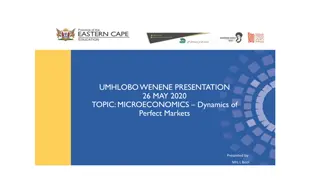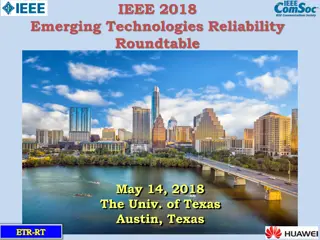Joint NEPOOL Markets and Reliability Committees Meeting December 6-8, 2022, Westborough, MA
A meeting discussing Resource Capacity Accreditation in the Forward Capacity Market, focusing on improving accreditation processes to support a reliable transition to clean energy. The presentation outlines the proposed improvements for FCA 19, emphasizing the accreditation of resources based on their reliability contributions to enhance capacity substitutability and cost-effective capacity procurement.
Download Presentation

Please find below an Image/Link to download the presentation.
The content on the website is provided AS IS for your information and personal use only. It may not be sold, licensed, or shared on other websites without obtaining consent from the author.If you encounter any issues during the download, it is possible that the publisher has removed the file from their server.
You are allowed to download the files provided on this website for personal or commercial use, subject to the condition that they are used lawfully. All files are the property of their respective owners.
The content on the website is provided AS IS for your information and personal use only. It may not be sold, licensed, or shared on other websites without obtaining consent from the author.
E N D
Presentation Transcript
J O I N T N E P O O L M A R K E T S A N D R E L I A B I L I T Y C O M M I T T E E S M E E T I N G D E C E M B E R 6 - 8 , 2 0 2 2 | W E S T B O R O U G H , M A Resource Capacity Accreditation in the Forward Capacity Market Continued discussion on conceptual design Feng Zhao Steven Otto E C O N O M I S T T E C H N I C A L M A N A G E R F Z H A O @ I S O - N E . C O M S O T T O @ I S O - N E . C O M ISO-NE PUBLIC
WMPP ID: 157 Resource Capacity Accreditation in the Forward Capacity Market Proposed Effective Date: FCA 19 The Resource Capacity Accreditation (RCA) project proposes improvements to ISO-NE s accreditation processes in the Forward Capacity Market (FCM) to further support a reliable, clean-energy transition by implementing methodologies that will more appropriately accredit resource contributions to resource adequacy as the resource mix transforms The ISO has made a commitment to file proposed improvements in time for FCA 19 The goal of this presentation is to summarize the MRI design discussed over the last six months and connect it with the primary benefits and objectives of the RCA initiative: Accredit all resources based on their marginal reliability contributions to improve capacity substitutability Through the improved accreditation, enable the ISO to more cost-effectively procure capacity from resources to meet the region s reliability objectives ISO-NE PUBLIC 2
WMPP ID: 157 Resource Capacity Accreditation in the Forward Capacity Market Proposed Effective Date: FCA 19 Outline of today s discussion: Review of MRI design framework (slides 5-24) Conforming changes to CNRC (slides 26-30) Conforming changes to auction mechanic changes (slide 32) Summary of RCA Improvements to Accreditation (slides 34-54) Improvements to Non-Intermittent Non-storage Accreditation (slides 37-41) Improvements to Storage Accreditation (slides 43-45) Improvements to Intermittent Accreditation (slides 47-50) Summary and Key Takeaways (slides 51-54) Stakeholder Schedule (slides 56-60) * Numerical examples are provided in appendices to illustrate diversity benefits between storage and intermittent, and show the QMRIC calculation for a resource with 0.1 MW FCA QC ISO-NE PUBLIC 3
MRI DESIGN FRAMEWORK Key concepts and processes ISO-NE PUBLIC ISO-NE PUBLIC 4
Introduced July MC/RC Meeting Key Concepts Marginal Reliability Impact (MRI), in hours/year, reflects a resource s expected availability when its capacity is needed for system reliability in RAA simulations MRI is calculated as the EUE/ QC, where EUE is Expected Unserved Energy A resource s new accredited capacity, Qualified MRI Capacity (QMRIC), reflects its expected output when its capacity is needed for system reliability in RAA simulations QMRIC is calculated as QC rMRI QC reflects the resource s measured output from the qualification process rMRI reflects a resource s relative MRIto perfect capacity: rMRI = MRI/MRIperfect ISO-NE PUBLIC 5
Introduced July MC/RC Meeting Key Concepts, cont d The market clearing yields two sets of obligation quantities The new Capacity Supply Obligation (CSO) or cleared QMRIC, and Effective CSO (ECSO), the physical obligation associated with the CSO Physical quantities QC ECSO 1/rMRI rMRI FCM Clearing Market quantities CSO QMRIC *Key concepts are highlighted in blue ISO-NE PUBLIC 6
Introduced September MC/RC Meeting Key Concepts, cont d Under RCA, the current system and zonal demand curves (delineating the marginal reliability benefits of total system and zonal QC levels) will be converted to QMRIC demand curves using rMRIz rMRIz represents the average rMRI of the system or zone, and is calculated as ????? ????? ?? ? ? ?????? ?? ???? ????? ?? ?? ? ? ?????? ?? ???? = QC-weighted average rMRI ISO-NE PUBLIC 7
Introduced July MC/RC Meeting KeyProcesses Resource Adequacy Assessment (RAA) is a probabilistic simulation process for calculating ICR and demand curves The process of using RAA to calculate MRIs and QMRICs is new RAA load and resource models are enhanced MRIs, QMRICs Enhanced load and resource modeling QCs RAA ICR, demand curves other parameters *Key processes are highlighted in blue ISO-NE PUBLIC 8
Connecting Design Elements: Illustrative Digram Market Clearing CSOs, ECSOs QMRIC demand curves Capacity Offers QMRICs System or zonal rMRIz Resource rMRIs QCs Enhanced load and resource models Qualification Process ICR, demand curves RAA Other parameters *Key concepts/processes are highlighted in blue ISO-NE PUBLIC 9
Introduced July MC/RC Meeting MRI Design Benefits From the previous diagram, it can be seen that capacity offers and demands are all based on QMRIC quantities under RCA QMRICs of demand and different resources are substitutable, and thus RCA will achieve more efficient market outcomes More detailed discussion of the benefits are provided by resource types in the later part of this presentation ISO-NE PUBLIC 10
Introduced July MC/RC Meeting MRI Design Framework: Major Changes RCA introduces a new MRI-based capacity accreditation called QMRIC Compared to QC, QMRIC captures the reliability impact of a resource s other parameters such as EFORd and the reliability interaction among all resources and load The new capacity market product will be based on QMRIC instead of FCA QC Offers and bids are based on QMRIC Clearing prices are based on CSO RCA will separate market quantities (QMRIC and CSO) from physical quantities (QC and ECSO) The separation is needed as different applications may require different quantities as input MRIs are calculated using the existing RAA process RAA resource and load models are enhanced for more accurate MRIs ISO-NE PUBLIC 11
Introduced September-November MC/RC Meetings Conforming Changes The concepts and processes below require conforming changes under RCA Key FCM parameters such as Net CONE and capacity demand curves need to be translated from QC space to QMRIC space Applications that use current CSOs need to be separated into applications that use CSOs and those that use ECSOs, depending on the need of each application Composite offers are no longer needed as QMRIC captures both summer and winter reliability contribution of a resource ISO-NE PUBLIC 12
MRI DESIGN: CAPACITY QUANTITIES ISO-NE PUBLIC ISO-NE PUBLIC 13
Capacity Quantities that Matter in RCA Only two sets of capacity quantities matter in RCA: QMRIC and CSO (cleared portion of QMRIC) QC and ECSO ( cleared portion of QC) These quantities define accreditation values and obligations Other quantities such as nameplate capacity may be used as an intermediate step of calculating intermittent resource MRIs, but their use is not required ISO-NE PUBLIC 14
Introduced July - November MC/RC Meetings QC and ECSO QC is a physicalquantitythat represents a resource s measured output during pre-selected hours QC is determined by the resource s own characteristics SeasonalQCs are defined in the current design ECSO is a physical obligation and represents the portion of QC associated with the cleared portion of QMRIC: ??? ????? ???? = ???/???? = ?? Cleared portion expressed as a ratio Seasonal ECSOs are introduced under RCA ISO-NE PUBLIC 15
Introduced July - November MC/RC Meetings QMRIC and CSO QMRIC is a marketquantitythat represents a resource s probability- weightedoutputs during simulated RAA reliability hours QMRIC is determined by both the resource s own characteristics, other resources and load As a market quantity, resource QMRICs can be uniformly increased or decreased by the same percentage without affecting market outcome (i.e., only relative value matters) QMRIC is an annual value for the annual market construct CSO is a market obligation and represents the cleared portion of QMRIC CSO is an annual value ISO-NE PUBLIC 16
Comparison of QC (ECSO) and QMRIC (CSO) QC or ECSO QMRIC or CSO Physical quantity Market quantity (only relative value matters) Measured Simulated (non-measurable) Seasonal Annual (result of annual product) Based on pre-selected hours Based on simulated RAA reliability hours Reflect resource s own characteristics Affected by load and other resources Can be modeled as feasible unit outputs for power flow studies May be infeasible unit outputs for power flow studies QMRIC does not replace QC both will be kept under RCA ISO-NE PUBLIC 17
Proposed Use of ECSO and CSO ECSO CSO CNRC will be established based on ECSO of new resources Capacity base payment will be calculated based on CSO Energy must offer rules will be based on ECSO PFP Obligation is defined based on CSO Reliability review will be conducted based on ECSO Monthly reconfiguration and bi-laterals will trade CSO quantities ISO-NE PUBLIC 18
QC is Needed Under RCA Currently, QC is an audited measure that is available for the ISO to track year-to-year performance or ratings of all resources Applications such as reliability review require physical quantities such as QC and ECSO (instead of QMRIC) to be used as feasible unit output QC is a defined capacity concept in current market rules Additional concepts such as nameplate capacity bring no obvious benefits to the capacity market Seasonal QCs rather than other quantities allow a more accurate representation of resource performance characteristics in an annual capacity market construct ISO-NE PUBLIC 19
MRI DESIGN: SEASONALITY IN THE ANNUAL MARKET ISO-NE PUBLIC ISO-NE PUBLIC 20
Introduced September - October RC Meetings Seasonal QCs in RAA RAA allows seasonal input parameters in calculating annual reliability indices Seasonal QCs for thermal resources and hourly output profiles for intermittent resources are proposed as RAA model enhancements This allows more accurate calculation of a resource s QMRIC, which reflects its aggregated reliability contribution from all seasons (shown in the following slide) * Note there is no conflict of using seasonal QCs in evaluating annual QMRIC! ISO-NE PUBLIC 21
QMRIC Captures Aggregated Reliability Contribution QMRIC as a resource s annual reliability contribution is calculated as ????? = ?? ???/?????????? MRI is defined as ( EUE/ QC) where QC represents annual FCA QC The following equality can be shown mathematically: ????? = ???????? ????????? + ???????? ????????? /?????????? Summer MRI is defined as ( EUE/ SummerQC) Winter MRI is defined as ( EUE/ WinterQC) QMRIC reflects a resource s aggregated seasonal reliability contributions ISO-NE PUBLIC 22
Example: Seasonal Break-down of QMRIC Consider one RAA reliability hour in summer and winter respectively, i.e., 50/50 summer/winter risk split MRI_perfect = 2 hours/years Resource A has a summer QC of 100 MW and a winter QC of 110 MW, and is always available Summer MRI = Winter MRI = 1 hours/year Summer reliability contribution is 50 MW, and winter reliability contribution is 55 MW Aggregated reliability contribution from both seasons is 105 MW Resource B has a summer QC of 110 MW and a winter QC of 100 MW, and is always available Summer MRI = Winter MRI = 1 hours/year Summer reliability contribution is 55 MW and winter reliability contribution is 50 MW Aggregated reliability contribution from both seasons is 105 MW Resource C has a summer QC of 210 MW and a winter QC of 210 MW, and is always available Summer MRI = Winter MRI = 1 hours/year Summer reliability contribution is 105 MW, and winter reliability contribution is 105 MW Aggregated reliability contribution from both seasons is 210 MW ISO-NE PUBLIC 23
Implications of Seasonal Break-down of QMRIC QMRIC will capture a resource s seasonal reliability contributions Composite offers are no longer needed In the previous example, if Resource C is a composite of A and B, it has the same QMRIC as the sum of A and B s QMRIC substitutability still holds with seasonal QCs since QMRIC is defined as annual reliability contribution ISO-NE PUBLIC 24
CONFORMING CHANGES TO CNRC ISO-NE PUBLIC ISO-NE PUBLIC 25
CNRC Overview Capacity Network Resource Capability (CNRC) is the MW quantity associated with a capacity network resource s interconnection service In current FCM, CNRC of a new resource is established based on its cleared QC MW, i.e., capacity supply obligation (CSO) ISO-NE PUBLIC 26
CNRC Interpretation and Application CNRC represents a resource s transmission capability preserved on the network in deliverability power flow studies CNRC reflects the resource s maximum output in those studies CNRC does notrepresent the resource s output limits in actual operations CNRC of an existing resource serves as the cap on Qualified Capacity (QC), i.e., QC CNRC ISO-NE PUBLIC 27
CNRC Interpretation and Application Is Unchanged Under RCA RCA separates the market quantities of QMRIC and CSO from the physical quantities of QC and ECSO CNRC as a physical quantity will continue to be established based on a new resource s cleared physical quantity, i.e., ECSO CNRC will continue to be applied as a cap on a resource s QC (i.e., QC CNRC) ISO-NE PUBLIC 28
CNRC Conforming Changes in Terminology CNRC is considered a physical limit and should be established based on physical quantity of a new resource The physical quantity associated with the obligation of a new resource is represented by ECSO under the RCA Proposed conforming changes would be to shift terminology from CSO to ECSO ISO-NE PUBLIC 29
Key Takeaways CNRC interpretation and application remain unchanged under RCA Conforming changes will be needed to shift terminology from CSO to ECSO ISO-NE PUBLIC 30
CONFORMING CHANGES TO AUCTION MECHANICS ISO-NE PUBLIC ISO-NE PUBLIC 31
With RCA Reforms, FCA will be Conducted in Terms of QMRIC The descending clock auction (DCA) and market clearing engine (MCE) will still determine awards and prices, but the FCA will now be conducted with respect to QMRIC rather than QC Capacity resources will decide whether to withdraw from the auction in a given round based on the price they would be paid for their QMRIC at that point in the DCA The auction starting price will still be set at max[1.6*Net CONE , Gross CONE ], where the CONE values will be in terms of QMRIC, as outlined in the October Conceptual Design presentation As under current rules: The auction administrator will determine each round s starting and end prices The MCE will be fed the withdrawal prices and quantities, as well as the other key auction parameters, and determine the combination of capacity awards that maximizes social surplus ISO-NE PUBLIC 32
SUMMARY OF RCA IMPROVEMENTS TO ACCREDITATION ISO-NE PUBLIC ISO-NE PUBLIC 33
Section Overview This section will describe, at a high level, the primary benefits provided by moving to MRI-based accreditation Three sub-sections will cover improvements to non- intermittent non-storage, storage, and intermittent resources respectively Focus on a system without winter risk to simplify discussion Subsequent discussion in the afternoon will provide an overview of the incorporation of winter risk into the accreditation process ISO-NE PUBLIC 34
All Resources Are Impacted by Change in Accredited Capacity from QC to QMRIC It is expected that the resource adequacy assessment may result in both summer and winter risks being identified Most resources will see their accredited capacity decrease from their existing QC, although some resources may see an increase (QMRIC > QC) As a result, the total quantity of capacity procured is likely to decrease Because most resources will have less accredited capacity, their cost per unit of accredited capacity will also increase Higher costs per unit of accredited capacity will likely lead to higher capacity offers, which in turn will likely increase the capacity clearing price compared to the current design Which effect (less accreditation, higher capacity price) will dominate is uncertain, will be resource specific, and will change over time ISO-NE PUBLIC 35
IMPROVEMENTS TO NON-INTERMITTENT, NON-STORAGE ACCREDITATION ISO-NE PUBLIC ISO-NE PUBLIC 36
MRI-Based Accreditation for Non-Intermittent, Non- Storage Resources With the RCA reforms, non-intermittent resources will be accredited based on their Marginal Reliability Impact (MRI), rather than their outputs over an audit window (the current QC accreditation) MRIs will be calculated using small changes in each resource s QC in RAA to measure their marginal impact on system expected unserved energy (EUE) Non-intermittent resources available capacity are created from their QC and their EFORd: in all hours in GE-MARS, these resources either perform at their QC when not on outage or at 0 MW when on outage or maintenance Intuitively, non-intermittent resources QMRIC is their expected performance (given by their available capacity) during the RAA MRI Hours ISO-NE PUBLIC 37
Primary Benefits of MRI-Based Accreditation for Non-Intermittent, Non-Storage Resources Accrediting non-intermittent, non-storage resources based on their marginal contribution to system reliability has two primary benefits to market efficiency: 1. Incorporates resources EFORd into their accreditation value Resources that have higher outage rates are more likely to be on outage when additional available capacity would decrease system EUE 2. Incorporates resources size into their accreditation value Resources that are larger are more likely to be on outage when additional available capacity would decrease system EUE because their outages are more likely to cause load shed ISO-NE PUBLIC 38
RCA Reforms Will Result in Compensation that Better Reflects Differences in Reliability Contributions Under existing rules, resources cleared in the market that are the same size but have different EFORd are compensated identically in the FCM E.g., a reliable 100 MW resource with an EFORd = 2% receives the same capacity market revenue as a less reliable 100 MW resource with an EFORd = 30% With the RCA reforms, a resource s EFORd will be incorporated into their accreditation value Resources that are more likely to be on outage during hours when the system needs them will generally be paid less than otherwise identical resources that are less likely to be on outage during those hours ISO-NE PUBLIC 39
RCA Reforms will Result in a Greater Decrease in Accredited Capacity for Larger Resources Under existing rules, resources that have identical properties except for their size are compensated identically per MW of qualified capacity E.g., a 100 MW QC non-intermittent, non-storage resource receives 10% of the capacity revenue as a 1,000 MW QC, otherwise identical, non-intermittent, non- storage resource Larger resources available capacity is more correlated with hours where system reliability is at risk A simple numerical example on the next slide demonstrates this point Under the RCA reforms, a resource s size will be incorporated into their accreditation value, so that larger non-intermittent, non-storage resources will be paid less per MW of QC than otherwise identical, smaller resources ISO-NE PUBLIC 40
Numerical Example: Larger Resources Have Outages that Are More Correlated with RAA MRI Hours Resource 1 is 100 MW and Resource 2 is 1,000 MW While Resource 1 s outage does not cause load shed, Resource 2 is larger and their outage has a larger impact on Available Capacity, leading to load shed Because Resource 2 s outages are more likely to result in load shed, their outages are more correlated with the RAA MRI Hours This correlation with the RAA MRI Hours will result in a decrease in their QMRIC QC Available Capacity A.C. After Outage 15,000 MW 15,000 MW Load EUE 0 MWh Resource 1 100 MW Resource 2 1000 MW 14,900 MW 14,000 MW 14,500 MWh 14,500 MWh 500 MWh ISO-NE PUBLIC 41
IMPROVEMENTS TO STORAGE ACCREDITATION ISO-NE PUBLIC ISO-NE PUBLIC 42
MRI-Based Accreditation for Storage Resources With the RCA reforms, storage resources will be accredited based on their Marginal Reliability Impact (MRI) rather than their performance during a 2-hour audit window (the current QC accreditation) Storage resources MRI will be calculated by small changes in their QC (and their associated storage limit), which leads to small changes in hourly charging/discharging patterns in RAA The small changes in their hourly charging/discharging MWs decrease EUE, yielding the resource s MRI Critically, storage resources hourly charging/discharging patterns are a function of their stored energy and maximum charge/discharge rate: resources with more stored energy will be able to discharge energy at their maximum capability for longer Additionally, resources with more stored energy take longer to charge ISO-NE PUBLIC 43
Primary Benefits of MRI-Based Accreditation for Storage Resources Accrediting storage resources based on their marginal contribution to system reliability has two primary benefits to market efficiency: 1. Incorporates resources stored energy into their accreditation value Resources with more stored energy are more likely to provide more energy during hours where additional energy would reduce EUE 2. Incorporates diversity benefits between storage and intermittent resources See AppendixA for a numerical example that shows how storage resources allow solar resources to have a positive MRI even when all hours with load shed occur after the sun has set ISO-NE PUBLIC 44
RCA Reforms will Result in Compensation that Better Reflects Resources Maximum Stored Energy Under existing rules, two storage resources that are identical but have different quantities of stored energy are compensated identically E.g., a 100 MW storage resource that can discharge for 2 hours receives the same capacity market payments as a 100 MW storage resource that can discharge for 8 hours Under RCA reforms, differences in stored energy across resources will be incorporated into their QMRIC, so that resources cleared in the market with less stored energy are likely paid less than otherwise identical resources with more stored energy ISO-NE PUBLIC 45
IMPROVEMENTS TO INTERMITTENT ACCREDITATION ISO-NE PUBLIC ISO-NE PUBLIC 46
MRI-Based Accreditation for Intermittent Resources With the RCA reforms, intermittent resources will be accredited based on their Marginal Reliability Impact (MRI), rather than their expected median output in a pre-defined set of reliability hours (the current QC accreditation) Intermittent resources MRI will be calculated by small changes in their QC, which lead to small changes in their hourly output profile in MARS The small increments in their hourly output profile decrease EUE, yielding the resource s MRI ISO-NE PUBLIC 47
Primary Benefits of MRI-Based Accreditation for Intermittent Resources Accrediting intermittent resources based on their marginal contribution to reliability has two primary benefits to market efficiency: 1. Intermittent resources will no longer be accredited only based on their expected performance in the pre-defined reliability hours, but will instead be accredited based on their performance during a wider set of hours that GE-MARS models as being important for system reliability (the RAA MRI hours) 2. MRI-based accreditation will account for correlated hourly output profiles within classes (e.g., when the sun is down, all solar resources produce zero energy) ISO-NE PUBLIC 48
RCA Reforms Will Consider a Broader Set of Hours When Accrediting Intermittent Resources Under existing rules, intermittent resources are only accredited based on their expected median performance in a pre-defined set of reliability hours Under the RCA reforms, intermittent resources performance in all hours modeled as being at risk for load shed in GE-MARS will be considered in their accreditation value As a result, cleared resources that are expected to perform better in RAA MRI Hours will be paid more, cleared resources that do not perform as well in RAA MRI Hours will be paid less ISO-NE PUBLIC 49
RCA Reforms Will Consider the Impact of Correlated Intermittent Resource Performance on Reliability Intermittent resources often have highly correlated outputs E.g., when the wind is strong, all wind resources in the same geographical area will generally have higher output As an intermittent resource class comprises a larger share of the resource mix, the hourly output profiles of the intermittent resources will be increasingly correlated with the RAA MRI Hours E.g., in a system that is predominantly wind resources, the vast majority of hours when the system is at risk will occur when the wind is not strong MRI-based accreditation accounts for the correlated performances of these resources This dynamic for intermittent resources is identical to the size correlation of individual non-intermittent resources (i.e., as a resource gets bigger, its non- performance is more correlated with when RAA MRI hours occur) ISO-NE PUBLIC 50


